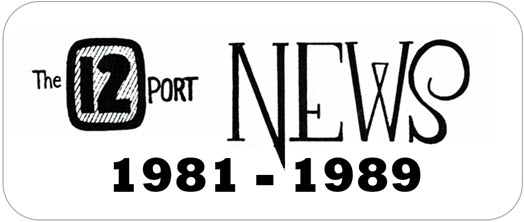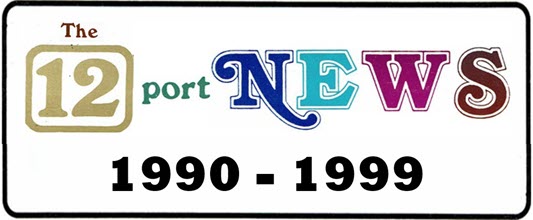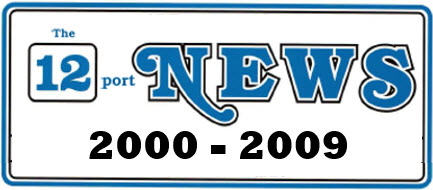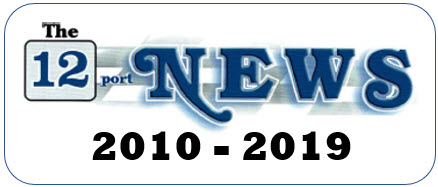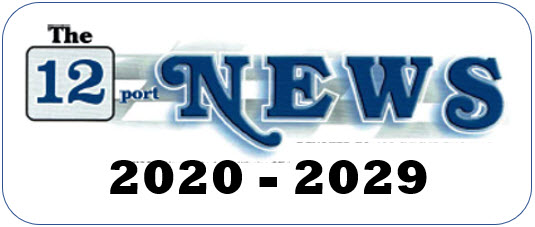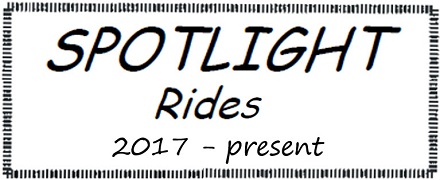Early history of inliners
- by Herbert Devon “Herb” Hall
Back in the 1970s, I, like many old car and truck folks, regularly read “Hemmings Motor News.” During the summer of 1976, I saw an ad from Rudy Purcell (later member #77) from Cleveland, Ohio. I connected with Rudy (who passed). We developed a friendship and Rudy and I bought stuff from each other. I had lots of car parts back then, including a pile of NOS Chevy stuff.
After a while, Rudy sent me the name of Charlie Baker of Nevada, Iowa. He and Charlie had done the same, bought and sold to each other and discussed tech stuff together. Rudy thought that Charlie would be interested in some things I had (that Rudy was not) and that Charlie would have stuff I was looking for.
So, in the summer of 1977, Charlie and I began to do what Rudy and I had been doing, namely, buying and selling to each other and exchanging tech info. One thing that Charlie purchased from me was my complete collection of Chevrolet Shop Manuals from 1930 thru 1970.
The early days of Inliners was a time before computers... all was done by hand or on a manual typewriter. I used a manual typewriter with carbon paper to have a copy of all correspondence -- Charlie Baker always wrote letters by hand.
One day in 1979, Charlie wrote to me about how he would like to start a club. He had a list of 40+ names of people that he had done business with all over the country. I agreed with Charlie that it would be a great idea.
There was not any official club yet formed. Charlie and I were working on it even before Don came on board. So, Charlie, Don and I were trying to get things figured out, get a Newsletter done; and a list of people as big as possible to mail the first issue to, in order to see what response we would get. We wrote back and forth a number of times about ideas of how to do it and set it up. We discussed everything ... the idea of a club, a Club newsletter; how to handle financial matters, etc. Charlie wasn’t certain how to go about some things and was very busy with his 9-5 day job at the Iowa Department of Transportation, where his wife Connie also worked. He was also trying to get his fledgling business “Vintage Development & Design” up and running
Charlie was having a terrible time getting a foundry that was competent enough to cast the aluminum 12 port head that he was working on. Charlie went through 2 or 3 foundries before he finally got someone to do it for him and even then there were issues. Had Charlie lived in Southern California, he probably wouldn’t have had such a hard time or spend many months in frustration and expenditures.
Don Kincaid, of course, was the first customer of VD&D (Vintage Development & Design), Charlie’s company to produce the 12 port heads. Don purchased the first head Charlie ever produced and they worked together on that.
I had experience helping start up a magazine in the early 1970s and had accounting classes. So, I knew what all was going to be necessary to get a newsletter up and running including financial. Charlie and I agreed, that getting a newsletter out was the best first step. Charlie felt that it would be best to wait until we got some feedback about a club from his contacts, and feedback from people to whom a first newsletter would be sent to, before trying to launch a club in any official manner.
Charlie and I were planning for me to do the first Newsletter. I was working on a first issue when Charlie wrote me and said that Don Kincaid of Turlock, California, really wanted to be the newsletter editor. This was my first introduction to Don.
At the time that the newsletter was started, Don and Wanda were on a Dairy Farm they started in 1977. Don ran his Father’s garment business before that and he loved all kinds of machinery, cars, trucks and farm equipment. Don first became the Newsletter Editor before he and Wanda were in the printing business. While on the farm, Don purchased and used a mimeograph machine to do the first issue of “The 12 Port News.” Shortly after this, Don used printing shops. Don started his printing business after he and Wanda sold their farm.
The first issue of ”The 12 Port News” (March, 1981) was done under “Vintage Development & Design” - Charlie’s business. No mention of a club in issue #1. At that time, there was the idea of a Club, as Charlie and I had been thinking, planning it for a couple of years. Basically, it was why we started this whole endeavor… Charlie wanted to be part of a Club and have all the inline “nuts” to be under our roof.
“The 12 Port News”- Issue #1 - was done and sent out by Don Kincaid. Don was also working very hard to promote the newsletter and the idea of a Club. Fortunately, he was on the west coast in California - the hot bed of inline engine innovation and racing. A large percentage of early members in Inliners were from California. Don had a lot to do with getting all those early California members. He was a tireless promoter and used the telephone a lot, which was a very expensive thing to do back then.
Don Kincaid and Gary Wise were, I feel, very close friends, and communicated often and regularly, especially on the phone. They both had an interest in 12 port heads. It was Don and Gary who came up with the name for the Club, “Inliners International.” “The 12 Port News” (Issue #2) announced that a Club had been formed, and that we were off and running. I believe that Don and Gary first connected as a result of the ad in “Hemmings Motor News,” that Charlie ran advertising his brand new 12 Port head, in the Fall of 1980.
Gary Wise became the Club’s very first official President. I am happy for Gary that he got to receive that honor.
“The 12 Port News” - Issue #3 - was the first spot color cover for the Newsletter. Don had tried to use color earlier for issue #2 but it turned out poorly. Don sent Charlie and myself a copy of that first color effort. I believe Don may have gotten rid of all of them because they looked so bad. He had just run off a few to test things out. I believe Charlie destroyed his. I kept mine just for historical reasons which I sent to the club Historian in 2004. So, it may be one of the only copies left of that first effort at a color cover.
I feel that Don always approached anything that he did with an expectation of himself to produce as near to a perfect result as possible. He had such a great, high level of expectation for anything that he did, especially for Inliners. Don’s constant striving for the very best quality was one of the reasons that the Club newsletter, “The 12 Port News,” has always been, right from the very early days, a publication with a level of quality and professionalism that far exceeds what could be reasonably expected, for a club of our size. That was especially true in the first few years when we were so small. Wanda has continued to keep that high level of quality and professionalism up since Don passed away.
At the time that Don asked to be the Newsletter Editor, I told Charlie that I did feel that spreading the work load out a bit, by sending the newsletter editor’s job out to Don was a good idea, and Don proved both Charlie and myself correct in that he did a fabulous job until he passed away and Wanda continued to do a fabulous job ever since. BTW ... I feel strongly that Wanda should be in the “Hall of Fame.”
I must stop here and mention all the great assistance Wanda Kincaid has lent me in getting things shaped up for this article. Thank you so much Wanda. I must mention that all the time Don did the Newsletter in his print shop, he always did it at cost to the Club.
During the first 3 to 4 years of publishing the newsletter, many articles that appeared under a member’s name, were actually written by me, including Charlie’s. Charlie would send notes to me, I would write/type the piece and mail it to Don in Turlock. I did not write things that had Don’s, the President’s or other officer’s names. Classified ads went primarily to Don directly.
When someone joined the club, I wrote back to them, sent their membership stuff, asked questions and for photos (to get information for articles for the newsletter). When the article ran, I would put member’s name on it instead of mine. I felt that members would really appreciate it and show the newsletter to all their friends... (hopefully, boosting membership a bit). Also, I felt that it was the right thing to do. Of course, some members sent pretty much “camera ready” articles.
Now, at one point early on, Charlie wanted the “Club” to be a “product” of VD&D, and when Issue #1 went out there was not yet “formally” a Club. It was definitely in the works, but the first issue went out before all the details of the Club got finally organized.
I thought maybe the idea of the “Club” being a “product” of VD&D, might fly, so I agreed. Don sent a business card to me after he had some printed up. He sent some to Charlie also. After a long discussion, it was decided that continuing to have the Club be a “product” of VD&D, might hurt membership if the “Members” THOUGHT that their money was going directly into Charlie’s pocket, which would NEVER have been the case. We were just hoping for the club to survive financially. But perception is important, so the idea of everything being a “product” of VD&D was scrapped, and a Club was named, started, and announced, in Issue #2.
I kept that card that Don had sent me because I was thinking historically. I remember joining the “National Street Rod Association” in its very early days and remembered discussing with the “Founders” of that organization at one of their annual conventions, their regret that they were not more careful about preserving things from the very early days. So, I kept the card for historical purposes.
One thing on membership numbers. In the NSRA having a low number was a major “thing” but Charlie took #12, because he was “12 Port Charlie.” Charlie wanted Hoy Stevens to be #1 because Hoy had kept all the tools, and dies etc, for manufacturing the Wayne 12 port head. Hoy was from Ohio, and Charlie had purchased all of that stuff from Hoy, so Charlie wanted Hoy to be #1, and then Bill Fisher to be #2 (Bill didn’t join then - Charlie just made him #2) … those were Charlie’s wishes. Don Kincaid took #3 and Gary Wise #4. I took #19 as I was not comfortable having a number lower than Charlie and 19 was my lucky number in those days.
Also included in the stuff I sent to Luke Lucas were (2) business cards. One an early VD&D card for Charlie, and the other one is one of the perhaps few copies still left. It is a “12 Port News” business card, and at the bottom it says … “The 12 Port News is a product of Vintage Development & Design; Nevada, Iowa.
Later, I took the train to California and stayed with Don and Wanda Kincaid (in Turlock, CA) and was welcomed in their home and treated like family. I also went to the annual Inliner picnic there which they had every year. I met some Inliner Members at that park while we enjoyed our get-together, including Jim Merritt (#173), a great guy, an early Club member who served as the Membership Chairman and Treasurer.
Well, I wanted to purchase the old GMC pickup from Don and I was planning to drive it back to Michigan. However, there was too much work to do on it. Even Don decided that, the long trip back to Michigan was not a safe bet. So, I left the truck and flew to Colorado Springs to visit some old friends who worked down the mountain in the Springs and lived in Divide, Colorado. I was there for 6 weeks and I found and purchased a really nice rust free older Chevy car which I drove back to Michigan stopping again at Charlie and Connie Baker’s home in Nevada, Iowa. I also met Joe Umphenour (#66), and the other club members from the Colorado area during my stay while looking for a nice older car.
I feel that many members today do not know that Charlie was in a wheelchair all his adult life. I know the full story of how that happened and I’ll get to that shortly. Connie and Charlie Baker welcomed me into their home... great people. I stayed with them for about a week during that visit. I attended that first ever “Inliners” Get-together which was held in Charlie’s shop in Nevada, Iowa. (I drove over there from Michigan). It was a gathering of mostly all the guys from Iowa that Charlie knew, many of whom were very early Inliner members. Rich Fox from San Mateo, California, and his racing partner flew in. Rich was, as I recall, head of maintenance for United Airlines at the San Francisco airport and he and his racing partner took the “jump seats,” and flew for free to Iowa, and then home, so they were there for that great event.
THIS IS THE STORY OF HOW CHARLIE BAKER ENDED UP IN A WHEELCHAIR ALL HIS ADULT LIFE: Back in the 1960s there was the “draft.” Every young man knew he was likely to get drafted and that meant going into the Army. If the Army was not your cup of tea, then you tried to get into the Air Force or the Navy. So, one day Charlie and his best buddy from high school drove over to Des Monies, Iowa, to visit the Navy recruiter. Charlie and his buddy decided to go back home to Nevada, Iowa, and think about it. (If you have never driven in Iowa, you cannot imagine how “ribbon like” the roads are there. They are a constant flow of up and down and up and down. As soon as you crest, you go down again. As soon as you bottom out, you start back up).
On the way home, Charlie’s buddy was driving his parent’s convertible. If you remember, the cars of those days had no seat belts. They went over one of the rises on the road and there, just over the crest, near the middle of their lane was a womanushpushing a baby carriage across the road. Charlie’s buddy, to keep from killing the lady and her baby, yanked the wheel sharply to the right to go behind them. He managed to do that and missed them. But as a result, the car hit the up slope of the edge of the road and the car flipped over. Charlie’s buddy had the steering wheel to grab on to but Charlie had nothing. The car threw Charlie out as it turned over. Charlie landed right on the base of his spine on the asphalt road surface, and the impact sheared the bottom of Charlie’s spine right off. He never walked again and remained in the wheelchair.
Charlie told me the worst decision he ever made in his life was not signing the enlistment form that day at the recruiter’s office. If he had, he would have been “officially” in the Navy on the drive home and would receive a 100% disability check every month for the rest of his life.
Hints: click About to close the side panel - or click this link to reload the page . . .

© 2016 Free HTML5 Template. All Rights Reserved. Designed by GetTemplates Demo Images: Unsplash

